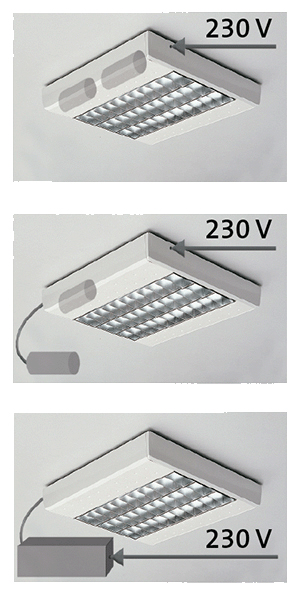Decentralised emergency lighting system
In a decentralised emergency lighting system, the back-up power is directly placed at the points of use, therefore each emergency lighting unit is provided with its own emergency lighting electronics and a rechargeable battery. The advantage of such a system is that the emergency lighting luminaires are independent of each other and requires neither complicated installations nor the use of fireproof cabling. A disadvantage is that the maintenance costs may be somewhat higher, since it requires servicing in more places instead of a single, centrally placed unit.
 The principle of a decentralised (self-supported) emergency lighting luminaire is to connect a unit for emergency lighting electronics between ordinary ballast and light source. This consists of a drive unit for the light source, a switch between normal and emergency mode and a battery charger. The parts are integrated into one unit.
The principle of a decentralised (self-supported) emergency lighting luminaire is to connect a unit for emergency lighting electronics between ordinary ballast and light source. This consists of a drive unit for the light source, a switch between normal and emergency mode and a battery charger. The parts are integrated into one unit.
During normal operation, when there is access to the mains, the light sources are operated by the normal ballast and the job of the emergency lighting electronics is to ensure that the battery remains well charged.
In emergency mode, i.e. a power failure, the normal ballast is automatically switched over from the circuit and the light source operation is taken over by the emergency lighting electronics.
When the mains power is restored, the circuit automatically switches back to the normal setting. With modern electronics, this switching happens with a short delay (0.5 sec) so that the HF ballast does not receive voltage before the lamp circuit has time to be restored 100 %. If the switching happens too quickly, the HF ballast’s monitoring circuit may detect that the fluorescent tube circuit is faulty and go into the standby setting to protect itself.
The majority of our HF luminaires can have an integrated emergency lighting function. Since some emergency lighting components, for example batteries, are sensitive to temperature the physical solution varies for each luminaire. Some luminaires require the battery or both the battery and the emergency lighting electronics to be moved outside the luminaire and placed in a separate box (battery and emergency lighting box).
For functional reasons, an emergency lighting box containing electronics may not be placed further away from the luminaire than 0.5 m. If the lamp cables become too long, the HF ballast’s function is affected or may not work in the emergency lighting mode. The battery box, however, can be placed up to 1 m from the luminaire. The distance may not be greater than 1 m due to the requirements in the current product standard (EN 60598-2-22).
A decentralised emergency lighting luminaire should normally be connected to the mains using a 4-core cable (protective earth, neutral, charge and ignition phase).
These cables must also be insulated for 230 V and be considered as mains connected from an installation perspective.
Decentralised emergency lighting luminaires, i.e. luminaires with integrated or closely positioned emergency lighting electronics and batteries, are suitable for use in areas with normal room temperature. Certain light sources may work at somewhat lower temperatures, for instance emLEDs light emitting diodes.